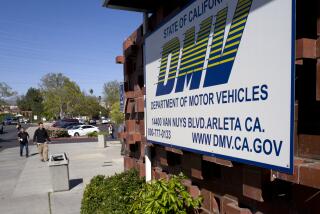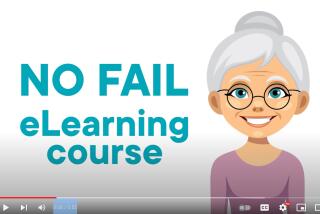Road Test a Tougher Course for Some
- Share via
Ed Marfori remembers when he got the scare of his life.
Marfori, a driving examiner at the Department of Motor Vehicle’s Glendale office, was testing the skills of a middle-aged woman who had barely driven anywhere but on city streets.
The woman cut a swath across the Ventura Freeway, he said, just missing speeding vehicles headed in their direction. It’s incidents like that, Marfori said, that “make me appreciate driving-school cars with two sets of accelerators, steering wheels and brakes.”
Better tighten your seat belt. You may be sharing the freeway with somebody practicing for the new and more difficult driving test that includes a spin on the freeway for the first time.
The tougher road exam--designed to better reflect today’s driving conditions--is being given in Los Angeles, Orange, San Diego and some parts of Ventura counties before it eventually becomes mandatory throughout the state.
Driver’s license applicants are spending more time on the road, driving about five miles instead of one, thereby giving the examiner more opportunity to ding them. They also are being sent home without being allowed to take the test if any essential equipment on their car isn’t working.
And more are failing. About 38% of driver’s license applicants are being sent away empty-handed, up from 26% for the old exam. At some DMV offices, nearly half of the test-takers are flunking.
In Glendale, meanwhile, the “new” test has been administered by DMV officials for two years. “The failure rate here is two times what it was before under the old test,” said J. Stephen Pierson, manager of the Glendale DMV office. “It’s longer and more comprehensive in part because of the freeway driving,” he said.
It’s not just having to drive a short distance on an often-perilous freeway that is putting the brakes on license hopefuls.
They’re doing things such as rolling through stop signs, changing lanes without signaling and not looking over their shoulders when merging--the kind of stuff you see licensed drivers do every day.
Some applicants are so fearful of driving on the freeway or have flunked so many times that they are traveling to outlying counties where the old exam is still offered.
Chris Humphries, manager at DMV’s Redlands office, said her office is administering as many driving tests to Los Angeles and Orange county residents as Inland Empire residents.
“It’s not something we can do anything about,” DMV spokesman William Madison said, since people can take the test anywhere in the state. No statistics were available on how many people are exercising that option.
This is the first major change to the test since pre-freeway days more than 50 years ago. First implemented two years ago, the test takes an average of 20 minutes, roughly seven minutes longer than with the old exam.
Now the scrutiny begins even before you turn on the engine.
DMV examiners want to know if applicants have practiced on the freeway. If they haven’t, the test is postponed.
Applicants must go through a more detailed pre-drive check to show that the car is in working order and that they know the location of important equipment, including emergency flashers, windshield wipers and the defroster. Get four of the six most critical checks wrong, and you’re finished for the day.
Instead of a short jaunt down quiet residential streets, test-takers must also drive through business districts and on the freeway, usually just in the far right lane and to the very next offramp. Examiners have more time to watch--and grade--how you change lanes, what type of stop you make when you pull up to an intersection, whether you scan for traffic and pedestrians, and whether you get up to speed merging onto the freeway. You must drive through eight intersections and make eight turns--more than required by the old test.
“We’re trying to raise the competency level,” said Michele Snyder, a manager in DMV’s driver licensing policy section in Sacramento and project leader for the new exam. “We’re hopefully having a positive impact on traffic safety.”
So tough is the test that some examiners have come close to failing in training sessions. Test-takers can make up to 15 mistakes but flunk on the spot if they commit any of several infractions--basically, the type of things that earn a ticket--such as running a red light or speeding.
Examiners wait until they get back to the DMV office before breaking the bad news. “I’ve had people, you tell them they fail, and they just don’t want to live anymore,” said Pasadena DMV examiner Clint Allen, who administers tests in English, Chinese and Spanish and with hand gestures to hearing-impaired applicants. “They start crying. They start begging you to pass them. And then they end up running into something.”
Failure rates were even higher until the DMV last year dropped a requirement that applicants pull into an 8-foot-wide parking space without hitting traffic cones on either side. Many test-takers brushed the cones and some knocked them over. “Obviously, we have folks out there who may not know how to park their cars very well,” Snyder said. The requirement was dropped to reduce the test time and save money.
Budget constraints also explain why the DMV needs time to gradually implement the test statewide and why examiners don’t take applicants on the freeway for a longer period. “We just do not have the time,” Snyder said, adding that the agency would have to hire more examiners or increase waiting times for driving tests.
Visit any participating DMV office and you can sense more nervousness among applicants--with good reason.
At the Glendale DMV office, some test-takers get so nervous “they don’t know how to find the horn or the emergency brake,” Marfori said.
In Fullerton, Raul Ramirez, 22, recently flunked his third test, this time for rolling through a red light on a freeway onramp. “It’s not the test,” he admitted later. “It’s me. I get nervous. Or, maybe I just don’t know how to drive.”
After failing the exam last year, Ramirez said he spent some time driving without a license, a practice that eventually cost him an $800 fine. So now he has a friend drive him to work, and is determined to follow the law.
“I have to practice more on the freeway,” he said. “I won’t give up; I hope the next test will be my last.”
Gail Kessler, licensing section manager at the DMV’s Fullerton office, described the new procedures as “so much more objective” than the old one--”a much truer test of their ability to drive safely.”
Examiners are now more confident about drivers they pass, Synder added.
“I was an examiner for years, and there were times when I got out of the car and thought to myself, ‘I can’t believe this person passed.’ You knew in your gut, if they didn’t get more practice, they were going to be out there having an accident in no time.”
Asked if licensed drivers should be concerned about sharing the freeway with those taking the test, Peter Flores, a DMV examiner in Hollywood, said, “If they’re that bad of a driver, they’re not gonna make it to the freeway.”
And if they do make onto the freeway and run into trouble, “we take over,” Flores said. Once an examiner intervenes verbally or physically, the test is over.
The test has proved tough even for experienced drivers.
In fact, a reporter who took the test failed. He was dinged for stopping too closely behind other cars (you should be able to see the rear tires of the car in front of you, Allen lectured), not looking over his shoulder to make sure the blind spot was clear, and rolling through a stop sign (you should stop for two to three seconds behind the line, Allen said).
Examiners are full of war stories.
At the Pasadena office, they point to a patched-up wall in the parking lot where several test-takers failed to apply the brakes.
Monte, of Fullerton, recalls one applicant who was pulled over for driving under the influence while taking the test. “I could write a book,” she said.
No statistics are available on the most common mistakes or who fails the most.
“Clearly, this test is a little tougher on senior drivers and novice drivers,” Snyder said. Referring to out-of-staters who are seeking their first license, and immigrants, she said, “The law does not require that they take any kind of professional driver instruction. Unfortunately, a lot of them are coming in with minimal instruction. And this is not a test they’re going to do well on unless they have learned how to drive.”
One common mistake applicants make is getting on the freeway too slowly, then getting off too fast. Another is not looking around enough.
“After many years, we develop bad habits of relying on our mirrors,” said Noma Luna, an examiner in Bellflower. “They say, ‘I’ve had a license for 15 years,’ and they’re not passing. They’ve got to go back to the basics: signal, look over your shoulder before you merge.”
That was a problem for Kersten Henshen of Silver Lake. After driving in her native Germany for 16 years and six months on California roads, she failed the test last week at the Glendale DMV office, in part because she merged too slowly onto the freeway. “It’s not like Germany,” she said after passing her exam the next day, “There are differences.”
At the Bellflower office, Jay Cleveland, 16, who passed the test on his second try, said, “It was nerve-racking.”
The freeway was the toughest part, he said, echoing a sentiment shared by others. “You don’t know what’s going to happen. There could be a million cars there. There could be none.” The examiner made a notation on the scoring sheet that Cleveland should use the “correct speed” while driving the freeway. “I was going too slow,” he said. “Usually, I go too fast when I am driving with my mom.”
Sixteen-year-old Victoria Young had just passed on her third try at the Pasadena DMV office. “It’s hard,” she said. “They told me I need to scan [look around] a little bit more.”
Her mother, Janice, like other parents waiting for their teenagers to take the test, said she was pleased that freeway driving has been added.
But even after congratulating her daughter with a big kiss, Mom said, “Just because you have a license doesn’t mean we won’t still practice.”
Rene Delgado, a Sun Valley resident, is a DMV security guard and has surveyed legions of drivers waiting to be tested.
“People should be thankful because the test weeds the bad drivers out from the good. If you know how to drive, you’ll pass no matter how hard it is,” he said.
Times staff writer Andrew Blankstein contributed to this report.






